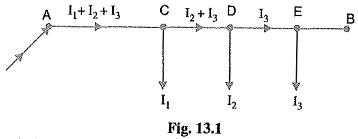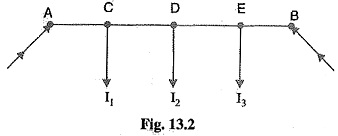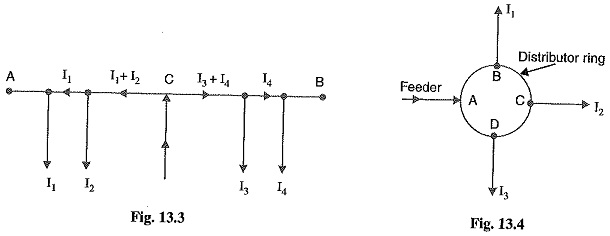Different Types of DC Distributors:
Different Types of DC Distributors – In the beginning of the electrical age, electricity was generated as a direct current and voltages were low. The resistance losses in the lines made it impracticable to transmit and distribute power for more than a few localities of the city. With the development of the transformer, a.c. has taken over the load formerly supplied by d.c. Now-a-days, electrical energy is generated, transmitted and distributed in the form of a.c. as an economical proposition. The transformer permits the transmission and distribution of a.c. power at high voltages. This has greatly reduced the current in the conductors (and hence their sizes) and the resulting line losses.
However, for certain applications, d.c. supply is absolutely necessary. For example, d.c. supply is required for the operation of variable speed machinery (e.g. d.c. motors), electrochemical work and electric traction. For this purpose, a.c. power is converted into d.c. power at the sub-station by using converting machinery e.g. mercury are rectifiers, rotary converters and motor-generator sets. The d.c. supply from the sub-station is conveyed to the required places for distribution. In this chapter, we shall confine our attention to the various aspects of d.c. distribution.
The most general method of classifying d.c. distributors is the way they are fed by the feeders. On this basis, Different Types of DC Distributors are:
- Distributor fed at one end
- Distributor fed at both ends
- Distributor fed at the centre
- Ring distributor.
1.Distributor fed at one end: In this type of feeding, the distributor is connected to the supply at one end and loads are taken at different points along the length of the distributor. Fig. 13.1 shows the single line diagram of a d.c. distributor AB fed at the end A (also known as singly fed distributor) and loads I1, I2 and I3 tapped off at points C, D and E respectively.
The following points are worth noting in a singly fed distributor :
- The current in the various sections of the Different Types of DC Distributors away from feeding point goes on Thus current in section AC is more than the current in section CD and current in section CD is more than the current in section DE.
- The voltage across the loads away from the feeding point goes on decreasing. Thus in Fig.13.1, the minimum voltage occurs at the load point E.
- In case a fault occurs on any section of the distributor, the whole distributor will have to be disconnected from the supply mains. Therefore, continuity of supply is interrupted.
2.Distributor fed at both ends: In this type of feeding, the distributor is connected to the supply mains at both ends and loads are tapped off at different points along the length of the distributor. The voltage at the feeding points may or may not be equal. Fig. 13.2 shows a distributor AB fed at the ends A and B and loads of I1, I2 and I3 tapped off at points C, D and E on decreasing as we move away from one feeding point say A, reaches minimum value and then again starts rising and reaches maximum value when we reach the other feeding point B. The minimum voltage, occurs at some load point and is never fixed. It is shifted with the variation of load on different sections of the distributor.
Advantages
- If a fault occurs on any feeding point of the distributor, the continuity of supply is maintained from the other feeding point.
- In case of fault on any section of the distributor, the continuity of supply is maintained from the other feeding point.
- The area of X-section required for a doubly fed distributor is much less than that of a singly fed distributor.
3.Distributor fed at the centre: In this type of feeding, the centre of the distributor is connected to the supply mains as shown in Fig. 13.3. It is equivalent to two singly fed distributors, each distributor having a common feeding point and length equal to half of the total length.
4.Ring mains: In this type, the distributor is in the form of a closed ring as shown in Fig.13.4. It is equivalent to a straight distributor fed at both ends with equal voltages, the two ends being brought together to form a closed ring. The Different Types of DC Distributors ring may be fed at one or more than one point.



